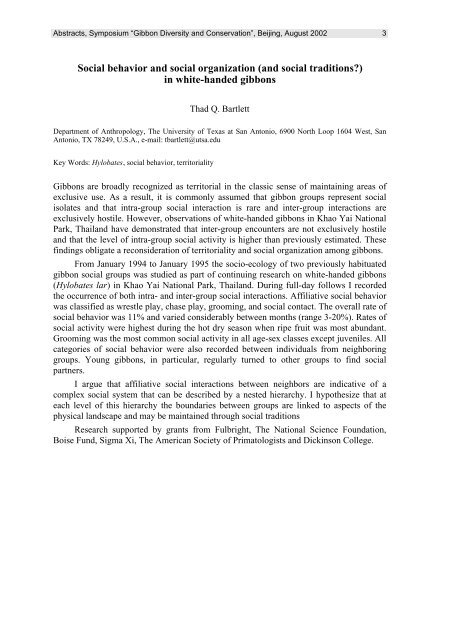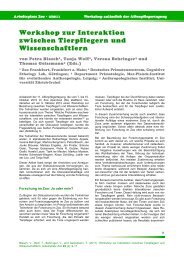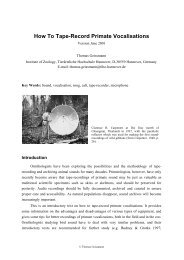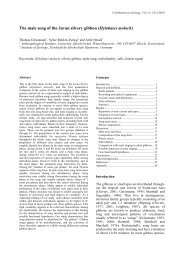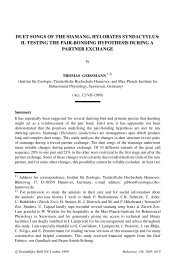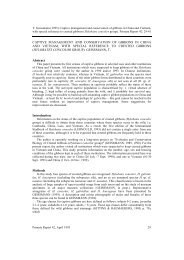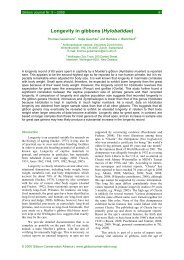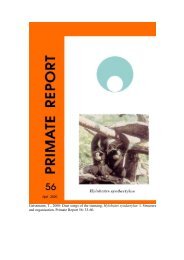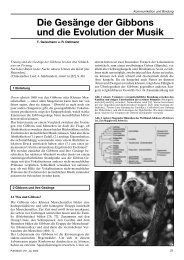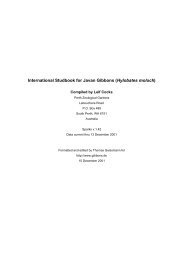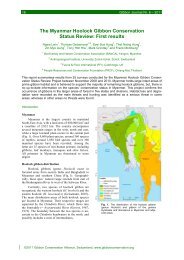Abstracts, Symposium “<strong>Gibbon</strong> Diversity and Conservation”, Beijing, August 2002 3Social behavior and social organization (and social traditions?)in white-handed gibbonsThad Q. BartlettDepartment of Anthropology, The University of Texas at San Antonio, 6900 North Loop 1604 West, SanAntonio, TX 78249, U.S.A., e-mail: tbartlett@utsa.eduKey Words: Hylobates, social behavior, territoriality<strong>Gibbon</strong>s are broadly recognized as territorial in the classic sense of maintaining areas ofexclusive use. As a result, it is commonly assumed that gibbon groups represent socialisolates and that intra-group social interaction is rare and inter-group interactions areexclusively hostile. However, observations of white-handed gibbons in Khao Yai NationalPark, Thailand have demonstrated that inter-group encounters are not exclusively hostileand that the level of intra-group social activity is higher than previously estimated. Thesefindings obligate a reconsideration of territoriality and social organization among gibbons.From January 1994 to January 1995 the socio-ecology of two previously habituatedgibbon social groups was studied as part of continuing research on white-handed gibbons(Hylobates lar) in Khao Yai National Park, Thailand. During full-day follows I recordedthe occurrence of both intra- and inter-group social interactions. Affiliative social behaviorwas classified as wrestle play, chase play, grooming, and social contact. The overall rate ofsocial behavior was 11% and varied considerably between months (range 3-20%). Rates ofsocial activity were highest during the hot dry season when ripe fruit was most abundant.Grooming was the most common social activity in all age-sex classes except juveniles. Allcategories of social behavior were also recorded between individuals from neighboringgroups. Young gibbons, in particular, regularly turned to other groups to find socialpartners.I argue that affiliative social interactions between neighbors are indicative of acomplex social system that can be described by a nested hierarchy. I hypothesize that ateach level of this hierarchy the boundaries between groups are linked to aspects of thephysical landscape and may be maintained through social traditions<strong>Research</strong> supported by grants from Fulbright, The National Science Foundation,Boise Fund, Sigma Xi, The American Society of Primatologists and Dickinson College.
Abstracts, Symposium “<strong>Gibbon</strong> Diversity and Conservation”, Beijing, August 2002 4Behavioral diversity within HylobatidaeWarren Y. Brockelman 1,2 and Udomlux Suwanvecho 21Center for Conservation Biology, ISTRD, Mahidol University, Salaya, Phutthamonthon, Nakhon Pathom73170, Thailand, e-mail: wybrock@cscoms.com2Department of Biology, Faculty of Science, Mahidol University, Rama VI Road, Bangkok 10400, ThailandKey Words: adaptive radiation, Hylobatidae, territorialityThe gibbons comprise a family of 11 species of apes which started speciating at least 5million years ago. This is ample time in which to have evolved behavioral and ecologicaldifferences among the species, yet all extant species appear to be characterized by smallterritorial groups, long term monogamous pairing, and loud songs which in most speciesare structured duets. This talk addresses three questions: (1) what behavioral variabilityexists among the species, (2) what is the range of variability within species, and (3) whathas constrained the evolution of behavioral and ecological diversity within the family.Detailed observations of behavior and ecology exist for nearly all species, but long termobservations of group formation and dynamics exist for only two: Hylobates(Symphalangus) syndactylus and Hylobates lar. The long term studies indicate that groupcomposition and pair formation methods are more flexible than previously thought, butthat long term monogamous pairing is the predominant, if not the sole, social pattern.<strong>Gibbon</strong> species differ in details of vocal behavior, song pattern, diet, and perhapsgroup size, but a lack of knowledge of the range of variation within most species precludesan assessment of the significance of species differences. It is <strong>here</strong> argued that the relativelack of behavioral diversity within the family Hylobatidae is due to ecological andassociated morphological constraints. Explaining how these constraints operate will requireanswers to the following questions: (1) why does the ‘gibbon niche’ require small groupsize and territorial behavior; (2) how have the gibbons’ food resource requirements andterritorial behavior prevented sympatry between the species (excepting the siamang), andhence largely restricted adaptive radiation within the family. More detailed and integratedstudies of ranging, diet, foraging, and social behavior, especially competition, are neededto answer these questions.
- Page 1 and 2: Thomas GeissmannInstitut für Zoolo
- Page 3 and 4: Symposium “Gibbon Diversity and C
- Page 5: Abstracts, Symposium “Gibbon Dive
- Page 9 and 10: Abstracts, Symposium “Gibbon Dive
- Page 11 and 12: Abstracts, Symposium “Gibbon Dive
- Page 13 and 14: Abstracts, Symposium “Gibbon Dive
- Page 15 and 16: Abstracts, Symposium “Gibbon Dive
- Page 18 and 19: Abstracts, Symposium “Gibbon Dive
- Page 20 and 21: Abstracts, Symposium “Gibbon Dive
- Page 22 and 23: Abstracts, Symposium “Gibbon Dive
- Page 24 and 25: Abstracts, Symposium “Gibbon Dive
- Page 26 and 27: Abstracts, Symposium “Gibbon Dive
- Page 28 and 29: Abstracts, Symposium “Gibbon Dive
- Page 30 and 31: Abstracts, Symposium “Gibbon Dive
- Page 32 and 33: Abstracts, Symposium “Gibbon Dive
- Page 34 and 35: Abstracts, Symposium “Gibbon Dive


